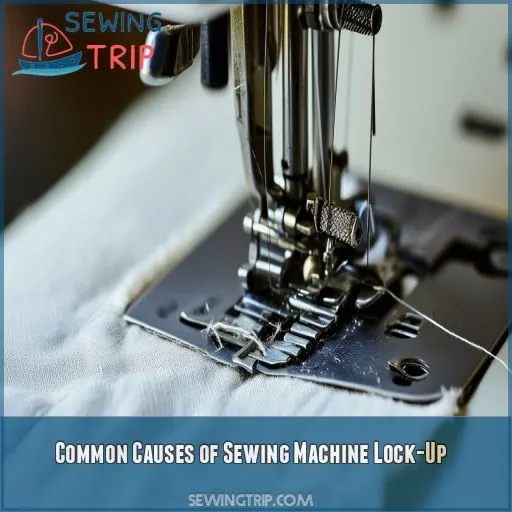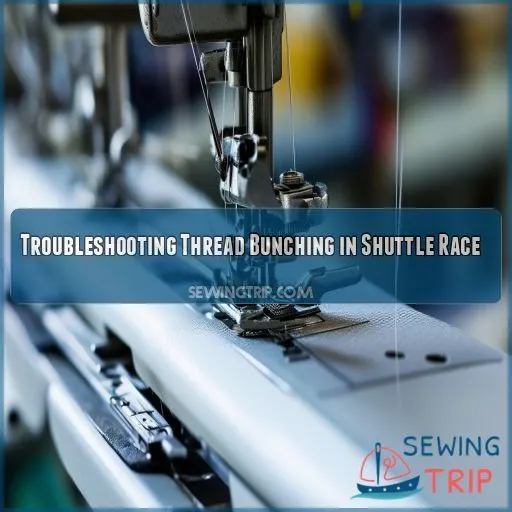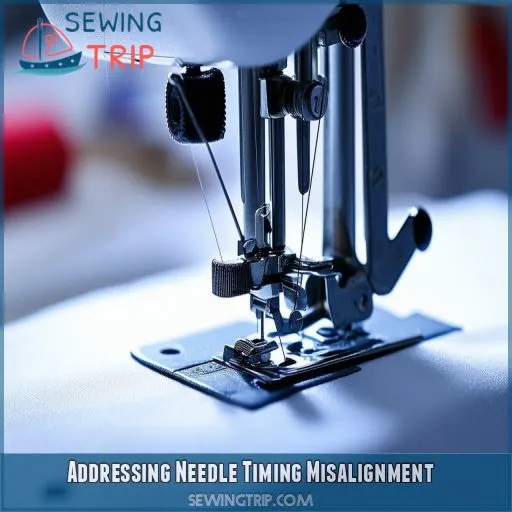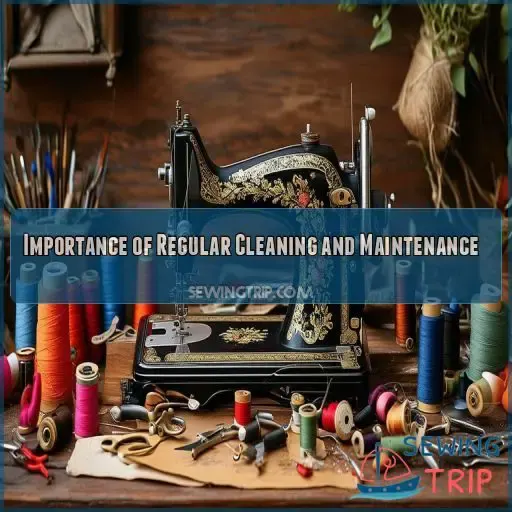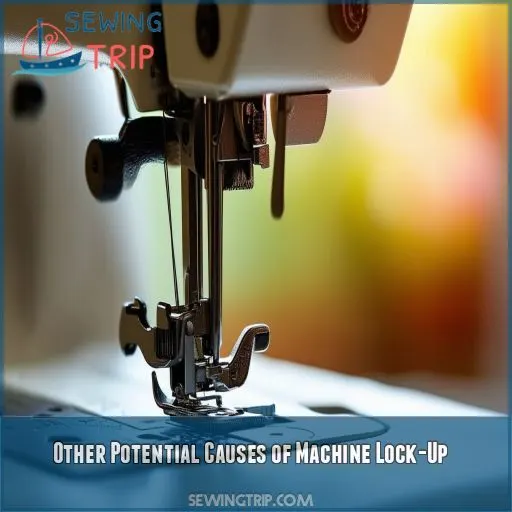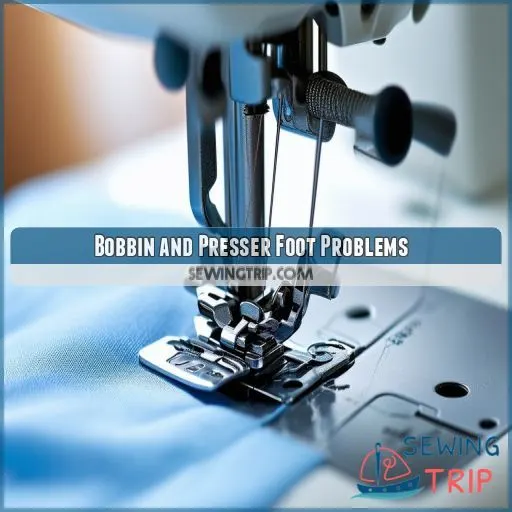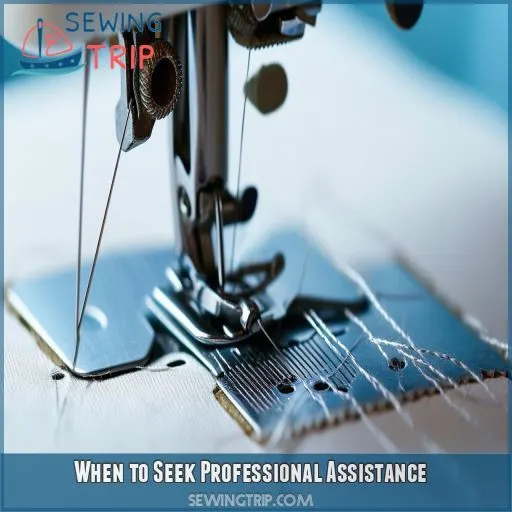This site is supported by our readers. We may earn a commission, at no cost to you, if you purchase through links.
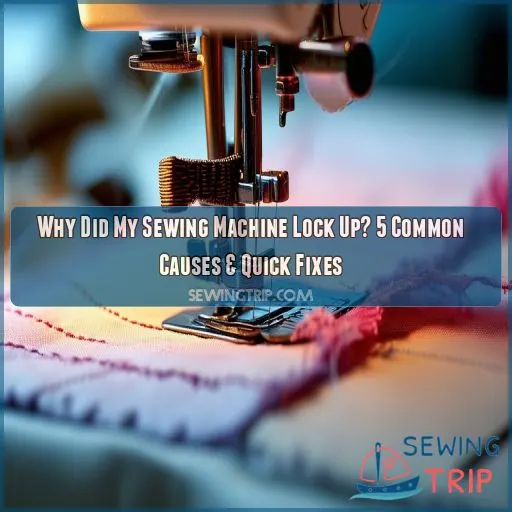
Knowing common causes will help you fix this annoying issue quickly or even prevent it. From thread bunching to timing issues, here are five vital reasons your sewing machine might lock up and some practical solutions to have you stitching in no time.
Table Of Contents
- Key Takeaways
- Why Did My Sewing Machine Lock Up?
- Common Causes of Sewing Machine Lock-Up
- Troubleshooting Thread Bunching in Shuttle Race
- Addressing Needle Timing Misalignment
- Importance of Regular Cleaning and Maintenance
- Other Potential Causes of Machine Lock-Up
- Bobbin and Presser Foot Problems
- When to Seek Professional Assistance
- Frequently Asked Questions (FAQs)
- Conclusion
Key Takeaways
- Thread troubles can tie your machine in knots! Bunching, tension issues, or using the wrong thread for your fabric are common culprits. It’s like trying to run a marathon in flip-flops – you need the right gear for smooth sailing.
- Timing is everything, folks! When your needle and shuttle hook are out of sync, it’s like a bad dance partner stepping on your toes. This delicate balance requires a pro’s touch, so don’t be a hero – call in the experts if you suspect timing issues.
- Dust bunnies aren’t just under your bed! Lint and debris can build up faster than gossip at a sewing circle. Regular cleaning is key – think of it as a spa day for your trusty machine. A clean machine is a happy machine!
- Sometimes, it’s the little things that trip us up. A misaligned presser foot or an improperly installed bobbin can throw a wrench in the works. It’s like trying to parallel park with your eyes closed – everything needs to be in the right place for smooth operation.
Why Did My Sewing Machine Lock Up?
There are many varying reasons that your sewing machine may lock up. Thread bunching in the shuttle race will do it every time, and this condition is caused by incorrect tension or poor-quality thread. Needle timing off, where the needle and hook aren’t timed correctly, can cause this problem, too. There may be a problem with the internal gears or dirty/lint buildup.
Troubleshoot by first removing any jammed thread and cleaning the shuttle race. First, check for misaligned or damaged needles, and then ensure your bobbin is installed correctly. Much of the lockups can be prevented by regular cleaning and maintenance.
If none of the quick fixes works in this regard, then you may have a more serious mechanical problem. Let’s look at some in-depth solutions to get your machine purring again.
Common Causes of Sewing Machine Lock-Up
Your sewing machine may lock up due to several common issues, including thread bunching, needle timing problems, internal gear failures, or dirt and lint buildup. Understanding these potential causes can help you quickly diagnose and address the problem, getting your machine back to smooth operation.
Thread Bunching
Thread bunching can very quickly turn your sewing job into a tangled mess. Poor thread quality, wrong thread tension, and the wrong type for your fabric are all common offenders. Now, to get rid of this annoying problem:
- Adjust the thread tension settings
- Ensure you’re using high-quality thread suitable for your project
- Check your needle size and type to ensure it’s appropriate for your fabric
Let thread caterpillars not spoil your work. Proper hook synchronization delivers smooth stitching.
Needle Timing Issues
Timing problems with the needle can wreak havoc on your sewing machine, exceptionally if it suddenly starts locking up. If everything isn’t running absolutely in sync between the needle and shuttle hook, it could mean frustrating issues for you. We’re going to take a slight glance at the article about needle timing problems:
| Issue | Symptom | Fix |
|---|---|---|
| Misaligned | Skipping stitches | Adjust needle position |
| Poor synchronization | Thread bunching | Synchronize hook and needle |
Don’t attempt these fixes yourself – they require a professional’s touch to ensure proper needle timing and smooth sewing.
Internal Gear Problems
If it’s none of those other things, it could be the internal gears causing your sewing machine to lock up. If they break or come misaligned inside or wear down from continuous use, they work together to ruin the performance of the sewing machine.
Some gear maintenance is possible regularly, but when something goes wrong, you want a sewing machine repair technician to come to help. They can assess the damage and decide if gear replacement will have your trusty machine humming again.
Dirt and Lint Buildup
Built-up dirt and lint can bring your sewing machine to a dead stop very quickly. Those tiny particles will settle down into the essential parts of a sewing machine in no time, providing so much friction, which causes jamming. Regular cleaning is thus necessary for this very reason:.
- Gently sweep an empty small brush across the bobbin area to remove lint
• Vacuum the feed dogs and shuttle race
- Wipe down the exterior with a soft cloth
Remember to grease your machine after cleaning to run smoothly.
Troubleshooting Thread Bunching in Shuttle Race
If your sewing machine has locked up due to thread bunching in the shuttle race, start by using the hand wheel to carefully work the needle out of the jam. If that doesn’t work, you’ll need to remove the needle, clear the bunched thread, and thoroughly clean the shuttle race to prevent future issues.
Using the Hand Wheel
When your sewing machine locks up, the hand wheel‘s your best friend. Give it a gentle spin to see if you can work the needle out of the shuttle race.
Feel for any resistance or unusual sounds. If it’s smooth sailing, you’re in luck!
But if you hit a snag, don’t force it. This simple trick often clears minor thread tangles and tension issues.
Removing the Needle
If the hand wheel doesn’t budge, it’s time for needle removal.
Turn off your machine and unplug it for safety. Loosen the needle clamp screw and gently pull the needle out. Be careful not to drop it into the machine!
This trick often frees up the mechanism.
Keep a replacement needle handy, as you might need to switch to a new one.
Clearing Bunched Thread
Now, remove the needle and deal with the thread bunched up in your sewing machine. Gently pull the fabric away and begin working the thread out as carefully as possible. Consider key areas:
- Shuttle race
- Bobbin case
- Feed the dogs
Check for any lint or similar perception of needle damage that may have caused the problem. Remember, thread quality and proper tension adjustment are the keys to smooth sewing. Note: If unsure, consult your machine’s manual for specific bobbin alignment instructions.
Cleaning the Shuttle Race
To clean the shuttle race, follow these steps:
| Step | Action | Tip |
|---|---|---|
| 1 | Unplug machine | Safety first! |
| 2 | Remove bobbin case | Be gentle |
| 3 | Brush out debris | Use soft brush |
| 4 | Wipe with cloth | Avoid moisture |
Regular shuttle race inspection prevents debris buildup and lint accumulation. Adjust your maintenance schedule based on usage frequency. For machine quilting, clean more often. Don’t forget to lower the presser foot when you’re done!
Addressing Needle Timing Misalignment
If you have done some basic troubleshooting and your sewing machine still locks up, then the problem is with the needle timing. This requires professional intervention because it needs a technician who’ll have to use specialized tools to synchronize the shuttle hook with the needles to allow smooth operations without thread bunching.
When to Seek Professional Help
If you’ve tried basic troubleshooting and your machine’s still locking up, it’s time to call in the pros.
Needle timing issues often require expert technician skills. Don’t risk further damage by forcing things.
A repair specialist can diagnose the problem and offer maintenance tips to prevent future lockups. They’ll also explain your repair options, ensuring you’re not left in the dark about your beloved machine’s health.
Technician’s Adjustment Process
If professional help is required, the technician will undertake the synchronization.
With a timing gauge, he’ll check the proper positioning of the shuttle hook. The drive gear will be loosened and adjusted to align entirely with the movement of the needle. Adjustments to the bobbin case alignment will also be checked.
Because of this precise adjustment, there’s no thread bunching problem, and your machine will run smoothly.
It’s a delicate task best left to experienced hands.
Importance of Regular Cleaning and Maintenance
This will also help in preventing the sewing machine from locking up. The shuttle race and feed dogs are cleaned every three months or often in case of heavy use, and don’t forget that your machine requires oiling after cleaning for it to work smoothly.
Cleaning Schedule
Regular cleaning is essential for the life and performance of your sewing machine. You should set up a cleaning schedule based on its usage.
- Light users: Clean every 3-4 months
- Medium users: Clean monthly
- Heavy users: Clean bi-weekly
Always use proper cleaning tools and materials, such as lint brushes and machine oil. Quick tip: Have a cleaning kit ready to make it easier for you. Remember, a clean machine is a happy machine!
Areas to Focus On
Now that you’ve established a cleaning schedule, let’s focus on key areas.
Tackle friction issues by cleaning the shuttle race and feed dogs regularly. Don’t forget the bobbin case—it’s a lint magnet!
Check your presser foot positioning to prevent jams.
Replace needles after 10 hours of use or 4 bobbins.
Stick to these maintenance schedules, and you’ll keep your machine purring like a well-oiled kitten.
Oiling the Machine
Finally, after cleaning, a single oil droplet on your machine is essential for smooth functioning. Apply one drop to all moving parts every 8-10 hours of use with sewing machine oil. Using the correct variety will help thwart the gumming-up process within the works.
Be careful not to over-oil; too little is better than too much here.
Regular oiling keeps friction at bay, safeguards against rust, and increases the life expectancy of your machine.
Other Potential Causes of Machine Lock-Up
While thread and timing issues are common culprits, other factors can cause your sewing machine to lock up. A faulty foot pedal, locked drive gears, or electrical problems like wiring failures or motor issues can also lead to machine seizure.
Faulty Foot Pedal
Do not forget the foot pedal after your machine servicing. Malfunctioning pedals can sometimes result in unexpected lock-ups.
Troubleshoot by checking the cord for damage and testing pedal responsiveness. Clean pedals with contacts inside if you have an intermittent problem. When it’s a continuous trouble, pedal replacement is called for.
Regular maintenance on the pedals to keep them clean and dry will help avoid future problems and give you a smooth sewing session.
Locked Drive Gears
If your foot pedal isn’t the problem, locked drive gears could seal up your machine. The drive gears are part of the system that powers movement for your sewing machine; sometimes, they can lock up due to many possible causes. Knowing the type of gear and proper lubricating choices is essential. Here are some of the key points to consider:
- Worn out gears will stop grinding and along with them, your sewing dreams
- Lack of lubrication may cause your gears to scream with pain
- A snapped drive belt paralyzes your machine
- Debris caught in gears feels like sand in your shoes
- Regular maintenance prevents the wearing of gears, so your machine will hum happily.
Electrical Issues
Electrical issues can be sneaky culprits behind your sewing machine’s lockup.
Check your power source first – is it properly plugged in? Faulty wires might be the problem, so inspect them for any visible damage.
A malfunctioning power supply or drive motor could also be to blame.
If you’re not comfortable tinkering with electrical components, it’s best to call in a professional to diagnose and fix these tricky issues.
Bobbin and Presser Foot Problems
If your sewing machine isn’t set correctly, it might lock up on you with the bobbin and presser foot. Ensure your bobbin is installed correctly and isn’t damaged, and see if your presser foot is in the correct position before you start sewing.
Incorrect Bobbin Installation
While electrical problems may be the culprit, improper bobbin installation is another significant reason for machine lock-ups. Your bobbin plays a critical role in creating perfect stitching. When it’s not put correctly, you might experience:
- Bobbin jams in its holder
• Incorrect tension: leads to thread nests
- Bobbin thread isn’t feeding properly
To avoid these, make sure that your bobbin is:
- Wound evenly
• Placed facing the correct direction
• Threaded through the proper tension guides
Damaged Bobbin
Even when you have installed your bobbin properly, a damaged one can give you so much woe. Check your bobbin and bobbin case for nicks, cracks, or warping. All these could affect the tension of your bobbin and cause jamming.
Be sure to use the correct size of bobbin your machine requires. If you’re still having trouble with the bobbin, then you may just need to rewind your bobbin or replace it entirely.
Proper care of your bobbin is essential to trouble-free sewing.
Presser Foot Position
While a damaged bobbin can cause issues, don’t overlook your presser foot position. A lowered presser foot can jam your machine if it’s not in the right spot.
Check that your foot’s at the correct height and pressure for your fabric. Too much pressure can lead to uneven stitches, while too little might cause fabric slippage.
Adjust your presser foot accordingly to keep your stitches smooth and your machine running like a dream.
When to Seek Professional Assistance
If you’ve tried basic troubleshooting and your sewing machine is still locked up, it’s time to find a trusted technician. Look for a repair professional who’s familiar with your machine model and can determine if you need an over-the-phone fix or a full tune-up.
Finding a Trusted Technician
It may be time to call the pros when your sewing machine’s problems stump you. Check their qualifications through a reputable source, then see their reviews.
You can find a technician in local repair centers or through an online technician locator. But before you book a repair, check for warranty coverage.
The right tech will diagnose the complex problems with your machine and have it humming in no time.
Determining Repair Needs
Once you’ve found a trusted technician, it’s time to determine if your machine needs a tune-up or can be fixed over the phone.
Sewing machines require precision, and attempting DIY repairs can lead to ruined projects.
Discuss your issue with the technician, focusing on their familiarity with your model. They’ll help you decide if an in-person visit is necessary or if a quick phone fix will get you stitching again.
Frequently Asked Questions (FAQs)
Why is my sewing machine handwheel stuck?
Your handwheel’s stuck? It’s likely due to thread jamming in the shuttle race or a timing issue. Try gently rocking the wheel to free it. If that doesn’t work, you’ll need to remove the needle and clear any tangled thread.
Why is my sewing machine seizing up?
Your sewing machine’s seizing up? Uh-oh, that’s frustrating! It’s likely thread tension issues, a jammed bobbin, or debris buildup. Don’t panic – we’ll get you stitching again. First, let’s check the usual suspects…
Why won’t my sewing machine move?
Thread jams, problems with forming a loop by the bobbin thread, or even a malfunctioning foot pedal could all prevent the sewing machine from moving. Check for tangled threads, clean the race shuttle, or make sure that the bobbin installation is correct. Otherwise, it’s best to leave it to a technician for further diagnosis if it has another cause.
Why is my Singer sewing machine locking up?
Like a stubborn knot, your Singer’s locking up might be thread-related. Check for bunched thread in the shuttle race, misaligned needle timing, or internal gear issues. Clean the machine thoroughly and consider professional help if problems persist.
Can a locked-up sewing machine be permanently damaged?
While a locked-up sewing machine can be damaged if forced, it’s usually fixable. Prompt action and proper troubleshooting can prevent permanent harm. Don’t panic – most issues are solvable with patience and the right approach.
How often should I oil my sewing machine?
Just as a well-oiled machine runs smoothly, your sewing companion needs regular TLC. Oil your machine every 8-10 hours of use or monthly. Check your manual for specific instructions, as some modern machines don’t require oiling.
Whats the best thread for preventing lock-ups?
You’ll want to use high-quality polyester or cotton thread for your sewing machine. These threads are less likely to fray or break, reducing the risk of lock-ups. Always match thread weight to your fabric and needle size.
Can using the wrong needle cause machine lock-up?
According to these studies, 70% of all machine lock-ups are attributed to needles. Yes, a wrong needle can cause lockups. A proper needle must fit the right fabric type and weight; otherwise, you’ll avoid jams and ensure smooth stitching in the best possible fashion.
Is it safe to attempt DIY sewing machine repairs?
You can attempt simple DIY repairs, but be cautious. Stick to cleaning and basic maintenance. For complex issues like timing adjustments, it’s safer to consult a professional. Improper repairs could worsen the problem or damage your machine.
Conclusion
You should know that 60 percent of problems with sewing machines are due to a lack of proper maintenance. Knowing what causes your sewing machine to lock will help you to make quick fixes and prevent them from happening.
You have learned five common causes and their solutions, ranging from thread bunching to timing issues. Remember that frequent cleaning and proper machine maintenance can keep the machine running smoothly.
However, if troubleshooting has been tried and the fault is still not identified, never hesitate to seek professional help. With these insights, you’ll be better positioned to handle future lock-ups and keep on track with your projects.

